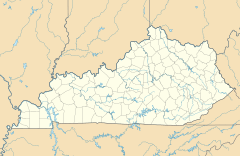Utica, Kentucky facts for kids
Quick facts for kids
Utica, Kentucky
|
|
|---|---|
| Country | United States |
| State | Kentucky |
| County | Daviess |
| Area | |
| • Total | 1.05 sq mi (2.73 km2) |
| • Land | 1.05 sq mi (2.72 km2) |
| • Water | 0.01 sq mi (0.01 km2) |
| Elevation | 417 ft (127 m) |
| Population
(2020)
|
|
| • Total | 298 |
| • Density | 283.81/sq mi (109.58/km2) |
| Time zone | UTC-6 (Central (CST)) |
| • Summer (DST) | UTC-5 (CST) |
| ZIP code |
42376
|
| FIPS code | 21-78708 |
| GNIS feature ID | 505928 |
Utica is a small, quiet place in Daviess County, Kentucky, in the United States. It's known as a census-designated place, which means it's a special area the government counts for population. In 2020, about 298 people lived there.
Contents
Where is Utica Located?
Utica is in the southern part of Daviess County. It's close to the border of McLean County. A main road, U.S. Route 431, goes right through the community. This road can take you 12 miles north to Owensboro. Or, if you head south for 24 miles, you'll reach Central City.
What Can You Find in Utica?
Even though Utica is a small community, it has some important places and services.
- It has its own post office, which uses the ZIP code 42376.
- There's a fire station to help keep everyone safe.
- You can find several churches for different faiths.
- There's a gas station and a couple of stores for daily needs.
- Utica also has a cemetery.
A Look Back at Utica's History
Utica was likely started a long time ago, in the early 1800s. It was probably named after the city of Utica, New York.
Mill Street's Story
One of the roads in Utica, Mill Street, has an interesting history. It got its name from a flour mill that used to be behind a place called JR's Market.
The Old Train Station
In the late 1800s and early 1900s, the first building on Mill Street was a train station. This station was very important! It helped people travel to Owensboro, a river town across the border from Indiana.
The Community Cemetery
The cemetery in Utica has graves dating back to the early 1900s. Most of the people buried there are from the 1930s onwards. People still use this cemetery today.
| Historical population | |||
|---|---|---|---|
| Census | Pop. | %± | |
| 1940 | 69 | — | |
| 2020 | 298 | — | |
| Bureau of the Census | |||


